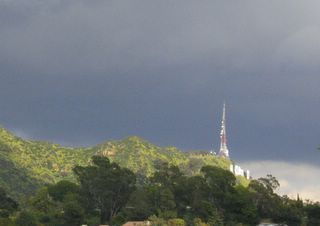Tonight I attended a lecture and musical performance at the Getty. GRI chief Tom Crow spoke rivetingly about Morton Feldman and Mark Rothko and the Rothko Chapel and the Feldman piece it inspired. I imagine that Crow's classes at Yale were great; he even timed the slides tonight to punctuate his jokes.
Four pieces by Feldman, starting with the Rothko piece after the talk and then, following an intermission and the departure of all but one member of the choir, compositions entitled Willem de Kooning, The Viola in My Life, and I met Heine on the Rue Furstenburg.
I'm impressed and a little mystified by people who can truly focus on and appreciate such stuff. When all else fails, I tend to focus on my breathing so as not to fall asleep. Or on whether the violinist is falling asleep. Or on how appropriate certain kinds of coughing can sound in the midst of the music. After one well-timed, one-note eruption from the peanut gallery, even the nervous cellist cracked a smile. Music to Have ADD to.
Gosh, I come off like a big fat Philistine, don't I? I did enjoy the work in my limited fashion. I enjoyed Tan Dun's "Water Passion After St. Matthew" at Disney Hall last night more, but that one was easy to love. Like a highbrow Laserium show (minus the lasers and the Pink Floyd and the pot).
Here are some of the more interesting things that crossed my mind tonight. Why? To get to the other side, silly.
1. Hi and LoDid the composers who scored '60s and '70s detective shows (e.g., Mission Impossible and
Mannix) study with giants of modern music before using their skills to heighten the tension of waterfront foul play, international diamond thievery, and car chases? The textures are strikingly similar. Short sharp flute arpeggios, woodpecker percussion, soft-attack oboe notes, and atonal vibraphone excursions. Etcetera. Somebody run out and fetch me a thesis. The perfect place to do research is just down the street -- the
Musician's Union on Vine near Melrose. Several pinochle games' worth of retirees are waiting to reminisce at this very moment. Call now -- senior citizens are standing by!
2. Everyone's Invited!If a cough can fit right in, why not channel the audience's contributions? It was mere months ago that I experienced a few performances of
spatial music, a form wherein some of the musicians do their jobs while stationed out in the audience. Let the audience pull its own weight, I say. Some people just can't keep quiet, between the gum wrappers and the rustling and the whispering and the purse zipping (are you listening, seat D 104? I'm talking about you.) I'd like to witness a performance that requires focused audience participation.
First, announce to the audience that everybody is a performer. No kumbayas or air guitar, please. There is real music played by real people with instruments, but at a certain point in the piece, a word or phrase appears on a screen above the stage. Red. Top. White. Om. The first words are short enough that the group pronounces them in unison. Once the group has the hang of it, introduce an element of abstraction, such as images or areas of color, increasing the complexity until the unanimity is lost. Then reintroduce simple words. Restore the unison. Then turn those words sideways: the word green written in bright orange. An image of the U.S. flag. Etcetera. Not sure how to end it. Maybe a cathartic group scream.
(And if they won't join in, take a page from William Castle's book and
electrocute them. Make them suffer for someone else's Art.)
Are both of these ideas old hat? I live in a vacuum. Hep me somebody. Use the comment field.
After the performance, I was on my way to the parking lot when I stopped. Never seen the Getty at night. Let's see how far I can get, I thought, leaping lightly up the deep stone steps to the plaza. Speaking of international diamond thieves, I was dressed in black and charcoal gray, so if anybody had seen me they might not have seen me. But if they had seen me when they saw me, they might have seen me as someone up to no good.
(We interrupt this irregularly scheduled narrowcast to bring you one of the best lines about L.A. ever committed to film. In
"The Limey," Luis Guzman is standing on a poolside deck outside a fancy Hollywood Hills house. He gestures vaguely westward through a soupy haze and offers, "You could see the sea if you could see it.")
Perhaps because access to the Getty campus is so well-controlled at the bottom of the hill, not a single security guard materialized to arrest my progress. Mind you, I wasn't whooping and doing cartwheels down the promenade, but the only people I saw were janitors. Two of them. My initial objective was to reach the far edge of the main level and perch there absorbing the city lights on this unusually clear night. When I reached the railing, however, the garden yawned out below me and I realized I'd never actually explored it. I had no idea how far down the pathways might go or if my after-hours actions were actionable, but the absence of "No" drove me forward. I slunk along the zigzagging stone walkways, noting by the trickle in the artificial gully below that the fountains must shut down after hours. Once again I arrived at an apparent endpoint and a railing overlooking the mid-lagoon topiary maze. Then I noticed that the paths circumnavigate the pool and extend through the lush plantings. I pressed on. I vaguely compared and contrasted the famously frictive architecture and landscaping. Would I want to be a
gardener there?
Two impressively bushy
brugmansia trees (aka the lovely and poisonous Angel's Trumpet) drew me close. Their broad canopies refuted the wisdom of my own brugmansia's recent savage pruning. Stanching regret, I expected to swoon at the perfume cloud that must hover around such well-developed specimens, but found the trees curiously discreet. No, it was sociable garlic that dominated the night air, even trumping night-blooming jasmine. For the second time in a night I was breathing deeply, this time not to stay awake but to identify the strongest fragrances.
If we dream four out of five dreams each night in black and white, my sojourn in the garden might as well have happened from the comfort of my own bed. Drained of color, the garden was all texture and fragrance and mystery. Even the most brilliant daytime colors were just shades of gray under the light pollution. For all the frenzied hours Monet spent capturing the light on
haystacks, he didn't stay up late nights worrying about shades of gray.
At one point, I turned from left to right and half-saw or felt a strong presence at my left elbow. My heart about jumped right out my mouth, but there was nothing. Nothing I could see, anyway. Did anybody die building that city of art and commerce? I kept moving. Inhaling deeply, sticking my snoot into flowers, treading softly on the decomposed granite walkways, I eventually made my way all the way around both sides of the lagoon and back to a set of well-lit steps. Yes, I engaged in more light leaping, thank you. The rough stones look disarmingly like the walls of Jerusalem's Old City. The smooth ones look like the walls of Jerusalem's new city. Heading back across the plaza to the tram stop I wondered if Getty scholars can stay late in the library and if they do, do they take midnight walks by the stilled fountain?
And because my exceedingly kind hosts at the Getty sometimes let me park at The Top of the Hill ("TOH!" cry the guards as I drive away), I was able to skip the tram and get into my car to drive down the hill. I dropped the roof to enjoy the clear night sky. Once I reached the unpoliced road downhill, I silenced the radio and extinguished first the headlights and then the motor itself. It was pure bliss, just the wind and trees and sky and freeway noise rushing past.
Or it might have been, but 10:30 is some kind of rush hour on the Getty access road, and I had to keep turning my lights back on to avoid colliding with shuttle buses. Yet even before the first of the four-ton killjoys hove into view, I was troubled by my failure to achieve vehicular satori in those few precious moments when everything was still perfect. I could have coasted all night, but after the interruptions, I just wanted the hill to end.
Yet as I neared the bottom, a tiny Disneyland thrill redeemed the trip and erased my chagrin. Much as one welcomes the return of civilization at the end of a ride that's outlasted its novelty, like Autopia or Storybook Land (note recent
mini-atrocity), I was mysteriously cheered by the gleaming yellow lights of the final approach. The effect simulates an amusement park. Intentional? Guards waved me through. The light changed almost immediately, and I was back in the real world, speeding home in my toy car listening to
the Art of Noise.
Kumbaya.






